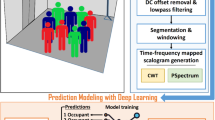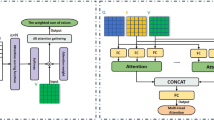Abstract
Accurate radio frequency power prediction in a geographic region is a computationally expensive part of finding the optimal transmitter location using a ray tracing software. We empirically analyze the viability of deep learning models to speed up this process. Specifically, deep learning methods including CNNs and UNET are typically used for segmentation, and can also be employed in power prediction tasks. We consider a dataset that consists of radio frequency power values for five different regions with four different frame dimensions. We compare deep learning-based prediction models including RadioUNET and four different variations of the UNET model for the power prediction task. More complex UNET variations improve the model on higher resolution frames such as \(256\times 256\). However, using the same models on lower resolutions results in overfitting and simpler models perform better. Our detailed numerical analysis shows that the deep learning models are effective in power prediction and they are able to generalize well to the new regions.












Similar content being viewed by others
Explore related subjects
Discover the latest articles and news from researchers in related subjects, suggested using machine learning.References
Ahmadien O, Ates HF, Baykas T, Gunturk BK. Predicting path loss distribution of an area from satellite images using deep learning. IEEE Access. 2020;8:64982–91.
Aldosary AM, Aldossari SA, Chen KC, Mohamed EM, Al-Saman A. Predictive wireless channel modeling of mmwave bands using machine learning. Electronics. 2021;10(24):3114.
Angeles JCD, Dadios EP. Neural network-based path loss prediction for digital tv macrocells. In: 2015 International Conference on humanoid, nanotechnology, information technology, communication and control, environment and management (HNICEM), IEEE, 2015; p. 1–9.
Ansari Y, Tiyal N, Feo-Flushing E, Razak S. Prediction of indoor wireless coverage from 3d floor plans using deep convolutional neural networks. In: 2021 IEEE 46th Conference on local computer networks (LCN), IEEE, 2021; p. 435–38.
Çiçek Ö, Abdulkadir A, Lienkamp SS, Brox T, Ronneberger O. 3d u-net: learning dense volumetric segmentation from sparse annotation. In: International conference on medical image computing and computer-assisted intervention. Lecture notes in computer science, vol. 9901. Springer; 2016, p. 424–32.
Ciresan D, Giusti A, Gambardella L, Schmidhuber J. Deep neural networks segment neuronal membranes in electron microscopy images. In: Advances in neural information processing systems, vol. 25. 2012. p. 2843–51.
Dargan S, Kumar M, Ayyagari MR, Kumar G. A survey of deep learning and its applications: a new paradigm to machine learning. Arch Comput Methods Eng. 2020;27(4):1071–92.
Drozdzal M, Vorontsov E, Chartrand G, Kadoury S, Pal C. The importance of skip connections in biomedical image segmentation. In: Carneiro G, et al, editors. Deep learning and data labeling for medical applications. DLMIA 2016, LABELS 2016. Lecture notes in computer science, vol. 10008. 2016. p. 179–87.
Erceg V, Greenstein LJ, Tjandra SY, Parkoff SR, Gupta A, Kulic B, Julius AA, Bianchi R. An empirically based path loss model for wireless channels in suburban environments. IEEE J Sel Areas Commun. 1999;17(7):1205–11.
Girshick R, Donahue J, Darrell T, Malik J. Region-based convolutional networks for accurate object detection and segmentation. IEEE Trans Pattern Anal Mach Intell. 2015;38(1):142–58.
Gupta S, Girshick R, Arbeláez P, Malik J. Learning rich features from rgb-d images for object detection and segmentation. In: European conference on computer vision. Lecture notes in computer science, vol. 8695. Springer; 2014, p. 345–60.
Hata M. Empirical formula for propagation loss in land mobile radio services. IEEE Trans Veh Technol. 1980;29(3):317–25.
He K, Zhang X, Ren S, Sun J. Spatial pyramid pooling in deep convolutional networks for visual recognition. IEEE Trans Pattern Anal Mach Intell. 2015;37(9):1904–16.
He K, Zhang X, Ren S, Sun J. Deep residual learning for image recognition. In: Proceedings of the IEEE Conference on computer vision and pattern recognition; 2016; p. 770–78.
Imai T, Kitao K, Inomata M. Radio propagation prediction model using convolutional neural networks by deep learning. In: 2019 13th European Conference on antennas and propagation (EuCAP), IEEE; 2019, p. 1–5.
Inoue K, Ichige K, Nagao T, Hayashi T. Learning-based prediction method for radio wave propagation using images of building maps. IEEE Antennas Wirel Propag Lett. 2021.
Jégou S, Drozdzal M, Vazquez D, Romero A, Bengio Y. The one hundred layers tiramisu: Fully convolutional densenets for semantic segmentation. In: Proceedings of the IEEE Conference on computer vision and pattern recognition workshops, 2017; p. 11–9.
Kingma DP, Ba J (2014) Adam: a method for stochastic optimization. arXiv preprint arXiv:14126980.
Levie R, Yapar Ç, Kutyniok G, Caire G. RadioUNet: fast radio map estimation with convolutional neural networks. IEEE Trans Wirel Commun. 2021;20(6):4001–15.
Lim B, Son S, Kim H, Nah S, Mu Lee K. Enhanced deep residual networks for single image super-resolution. In: Proceedings of the IEEE Conference on computer vision and pattern recognition workshops, 2017; p. 136–44.
Litjens G, Kooi T, Bejnordi BE, Setio AAA, Ciompi F, Ghafoorian M, Van Der Laak JA, Van Ginneken B, Sánchez CI. A survey on deep learning in medical image analysis. Med Image Anal. 2017;42:60–88.
Long J, Shelhamer E, Darrell T. Fully convolutional networks for semantic segmentation. In: Proceedings of the IEEE Conference on computer vision and pattern recognition, 2015; p. 3431–440.
Milletari F, Navab N, Ahmadi SA. V-net: Fully convolutional neural networks for volumetric medical image segmentation. In: 2016 Fourth International Conference on 3D Vision (3DV), IEEE; 2016, p. 565–71.
Mohammadjafari S, Roginsky S, Kavurmacioglu E, Cevik M, Ethier J, Bener AB. Machine learning-based radio coverage prediction in urban environments. IEEE Trans Netw Serv Manag. 2020;17(4):2117–30.
Moraitis N, Tsipi L, Vouyioukas D, Gkioni A, Louvros S. Performance evaluation of machine learning methods for path loss prediction in rural environment at 3.7 GHz. Wirel Netw. 2021;27:4169–88.
Nobuaki K, Yamada W, Sasaki M, Takatori Y. Convolutional neural network for prediction method of path loss characteristics considering diffraction and reflection in an open-square environment. In: 2019 URSI Asia-Pacific Radio Science Conference (AP-RASC), IEEE; 2019, p. 1–3.
Pinheiro PH, Collobert R. Recurrent convolutional neural networks for scene labeling. In: 31st International cnference on machine learning (ICML), vol. 32, no. 1. 2014. p. 82–90.
Popoola SI, Misra S, Atayero AA. Outdoor path loss predictions based on extreme learning machine. Wirel Pers Commun. 2018;99(1):441–60.
Radenović F, Tolias G, Chum O. Cnn image retrieval learns from bow: unsupervised fine-tuning with hard examples. In: European conference on computer vision. Lecture notes in computer science, vol. 9905. Springer; 2016, p. 3–20.
Radenović F, Tolias G, Chum O. Fine-tuning cnn image retrieval with no human annotation. IEEE Trans Pattern Anal Mach Intell. 2018;41(7):1655–68.
Rautiainen T, Wolfle G, Hoppe R. Verifying path loss and delay spread predictions of a 3d ray tracing propagation model in urban environment. In: Proceedings IEEE 56th Vehicular Technology Conference, vol. 4. IEEE; 2002. p. 2470–4.
REMCOM. Wireless insite, v3.3. 2020. https://www.remcom.com/wireless-insite-em-propagation-software. Accessed 11 Mar 2020.
Ronneberger O, Fischer P, Brox T. U-net: convolutional networks for biomedical image segmentation. In: Navab N, Hornegger J, Wells WM, Frangi AF, editors. Medical image computing and computer-assisted intervention—MICCAI 2015. Cham: Springer International Publishing; 2015. p. 234–41.
Schorr C, Goodarzi P, Chen F, Dahmen T. Neuroscope: An explainable ai toolbox for semantic segmentation and image classification of convolutional neural nets. Appl Sci. 2021;11(5):2199.
Selvaraju RR, Cogswell M, Das A, Vedantam R, Parikh D, Batra D. Grad-cam: visual explanations from deep networks via gradient-based localization. In: Proceedings of the IEEE International Conference on computer vision, 2017; p. 618–26.
Simonyan K, Zisserman A. Very deep convolutional networks for large-scale image recognition. arXiv preprint arXiv:14091556. 2014.
Springenberg JT, Dosovitskiy A, Brox T, Riedmiller M. Striving for simplicity: the all convolutional net. arXiv preprint arXiv:14126806. 2014.
Szegedy C, Liu W, Jia Y, Sermanet P, Reed S, Anguelov D, Erhan D, Vanhoucke V, Rabinovich A. Going deeper with convolutions. In: Proceedings of the IEEE Conference on computer vision and pattern recognition, 2015; p. 1–9.
Teganya Y, Romero D. Deep completion autoencoders for radio map estimation. IEEE Trans Wirel Commun. 2021.
Thrane J, Zibar D, Christiansen HL. Model-aided deep learning method for path loss prediction in mobile communication systems at 2.6 ghz. IEEE Access. 2020;8:7925–36.
Timoteo RDA, Cunha D, Cavalcanti GDC. A proposal for path loss prediction in urban environments using support vector regression. In: Proc. Adv. Int. Conf. Telecommun, vol. 10. 2014. p. 119–24.
Wahl R, Wölfle G, Wertz P, Wildbolz P, Landstorfer F . Dominant path prediction model for urban scenarios. In: 14th IST Mobile and Wireless Communications Summit, Dresden (Germany), 2005.
Wu L, He D, Ai B, Wang J, Qi H, Guan K, Zhong Z. Artificial neural network based path loss prediction for wireless communication network. IEEE Access. 2020;8:199523–38.
Yi Z, Zhang H, Tan P, Gong M. Dualgan: unsupervised dual learning for image-to-image translation. In: Proceedings of the IEEE International Conference on computer vision, 2017; p. 2849–857.
Zhang X, Shu X, Zhang B, Ren J, Zhou L, Chen X. Cellular network radio propagation modeling with deep convolutional neural networks. In: Proceedings of the 26th ACM SIGKDD International Conference on knowledge discovery & data mining, 2020; p. 2378–386.
Zhang Y, Wen J, Yang G, He Z, Luo X. Air-to-air path loss prediction based on machine learning methods in urban environments. Wirel Commun Mob Comput. 2018;2018.
Zhao B, Feng J, Wu X, Yan S. A survey on deep learning-based fine-grained object classification and semantic segmentation. Int J Autom Comput. 2017;14(2):119–35.
Acknowledgements
This research is in part supported by Communications Research Centre (CRC) Canada.
Author information
Authors and Affiliations
Corresponding author
Ethics declarations
Conflict of interest
The authors declare that they have no conflicts of interest.
Additional information
Publisher's Note
Springer Nature remains neutral with regard to jurisdictional claims in published maps and institutional affiliations.
Rights and permissions
About this article
Cite this article
Ozyegen, O., Mohammadjafari, S., Cevik, M. et al. An Empirical Study on Using CNNs for Fast Radio Signal Prediction. SN COMPUT. SCI. 3, 131 (2022). https://doi.org/10.1007/s42979-022-01022-2
Received:
Accepted:
Published:
DOI: https://doi.org/10.1007/s42979-022-01022-2




